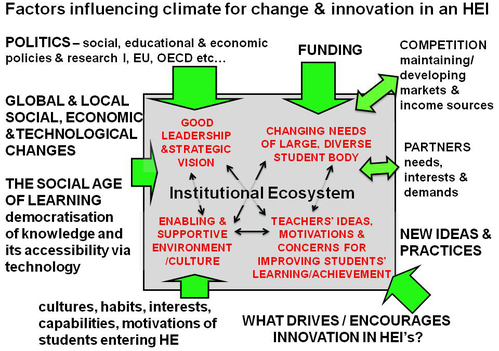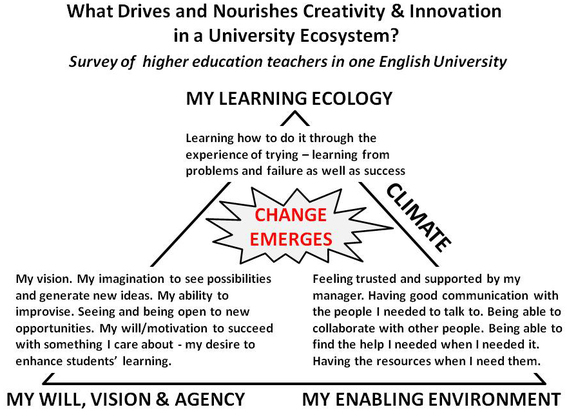
The term climate is used in schools, particularly in the USA, where it refers to 'the quality and character of school life'.... School climate reflects the patterns of students', parents' and school personnel's experience of school life and the norms, goals, values, interpersonal relationships, teaching and learning practices, and organizational structures - its an experiential phenomenon (1). This meaning focuses on a particular school environment, how it is experienced and what it feels like but the same term might be used to describe the atmosphere in other contexts.
Climate as a complex atmospheric phenomenon, is influenced by many factors that change over time. It clearly exerts enormous influence on the living things and the physical environment within a particular climatic zone. Humans adapt to live our everyday life in different climatic zones and as change is slow, in general, we are able to cope with the effects of change. Within climate zones we have weather and weather can sometimes be extreme. Weather determines our daily responses to living within a particular climate and often demands an immediate response in our behaviours - for example to avoid getting soaked, frozen, over heated or blown away.
Both climate and weather provide us with metaphors for viewing the conditions for, and responses to, change within an ecosystem. If we take the educational ecosystem climate relates to the fundamental pattern of beliefs and ideas within a society about the aims and purposes of education, conceptions of learning and the way learning can be encouraged and supported and the ways in which institutions are configured to support students learning and development. The educational climate is sustained by the global patterns of thinking and behaviour of the people who teach, develop, research, administer and lead and govern our educational institutions and systems. Changes in this pattern of thinking and behaviour happen relatively slowly through the sharing and discussion of new ideas as they emerge and are distributed through books, media and conferences, and slowly translated into new beliefs and social practices of the people who work in higher education and policies that shape or control behaviour.
Within this constellation of climatic beliefs and ideas we have the equivalent of weather. In English higher education for example, these are such things as new government policies like the introduction and subsequent raising of tuition fees, or additional funding for certain types of activity - like widening participation, or new forms of regulation like the Quality Framework developed by QAA at the start of 21st century, the National Student Satisfaction Survey, or the introduction of new institutional policies, frameworks strategies and imperatives. Like the weather we experience on a daily basis, such things require us to respond quickly and collectively they combine to produce a climate within which people develop their sense of belonging and attitudes to change in their own work environment. We all have to prioritise our efforts and most individuals respond to the drivers of change only when they have to. But some individuals who develop and lead new practices, strategies and technological developments (innovators, developers and managerial leaders) generate their own 'weather' when they come up with new ideas and invent new social and/or technological practices and these can impact on the wider institutional environment.
Which brings me to the idea that organisations create their own climates and micro-climates reflecting the culture, the way people feel about their environment and the way people think and behave within their work environment. Organizational climate generally refers to the degree to which an organization focuses on and emphasizes such things as: concern for employee well-being and their learning and development, encouragement, involvement and empowerment of people working in the organisation, and appreciation and recognition for their efforts and achievements, and support for individuals' creativity and innovation. I've been fortunate in my career to feel that the environments I have worked in have generally enabled me to feel I could try to do things that required my creativity without fear of being pilloried if I failed. But I also recognise that this feeling is a very personal thing as I have worked alongside colleagues who experienced the same organisational environment in a different way because, for example, they had a more difficult relationship with our manager. So 'climate' is both a general set of circumstances that shape our attitudes and beliefs and a particular set of experienced circumstances and relationships that affect us as individuals and enable or inhibit our thinking and actions. This way of thinking brought home to me the importance of the climate that envelops us in our ecologies for learning, developing and achieving (2) in which we use our creativity, and how a positive and optimistic orientation to the climate in which we work, stimulates or inhibits our creativity to produce very different results and performances.
A higher education institution is a specialised eco-social system in which the inhabitants relate and interact for the purpose of learning and the development of knowledge and understanding. Each institution has physical features & cultural characteristics that are particular to itself and the people who inhabit it. The ecosystem is connected and open to the flow of ideas, influences and relationships with the world outside the institution. These continuous interactions result in change as people in the organisation assess and respond to emerging situations to adapt to, and take advantage of changing circumstances. Some of the more important factors that affect the climate for educational change, and encourage people to innovate their practices, are shown in the adjacent diagram.

Factors and conditions that support, encourage and enable strategic change through bottom-up innovation (2). These influence the climate for change within an institutional ecosystem
Leadership, management & facilitation of strategic change & bottom up innovation
1 Leadership is shared and distributed throughout the organisation
2 A strategic vision that inspires people to create their own visions for change that they will embody
3 A strategy for both planned and emergent change
4 A strategy that involves the whole socio-cultural environment
5 Involvement of agents or brokers to facilitate change across and between organisational structures, hierarchies and boundaries
6 The provision of additional resources and an effective but flexible approach to managing and accounting for their timely distribution
Environmental /cultural factors that support, encourage and enable strategic change and bottom-up innovation
An environment/culture that :
- promotes effective, honest and meaningful communication
- recognises and supports resolution of local contentious practice and facilitates rather than inhibits progress
- encourages/facilitates new relationships and collaborations to foster change
- provides emotional support and celebrates what has been achieved
- values learning and encourages and enables people to share what has been learnt so that it can be used and adapted to other contexts
- encourages people to take risks to put themselves into unfamiliar situations where they need to harness their creativity to realise their ideas and actualise themselves
The relationships innovators have with their environment (including it's climate) is profound. In the words of Carl Rogers (3) creativity is 'the emergence in action of a novel relational product growing out of the uniqueness of the individual on the one hand, and the materials, events, people, or circumstances of his life' This ecological concept of creativity in which climate and culture influence attitudes and behaviours, fits well with the idea of organisations behaving as an ecosocial system and there is a strong overlap with the extensive organisational research conducted by Amabile and Kramer (4) on the socio-cultural work environment who identified four categories of nourishers that have a significant impact on the way people feel about their work environment and on their creativity, productivity and performance in their work namely:
1 Respect - managerial actions determine whether people feel respected or disrespected and recognition is the most important of these actions.
2 Encouragement - for example when managers or colleagues are enthusiastic about an individual's work and when managers express confidence in the capabilities of people doing the work increases their sense of self-efficacy. Simply by sharing a belief that someone can do something challenging and trusting them to get on with greatly increases the self-belief of the people who are engaging with the challenge.
3 Emotional support - People feel more connected to others at work when their emotions are validated. This goes for events at work, like frustrations when things are not going smoothly and little progress is being made, and for significant events in someone's personal life. Recognition of emotion and empathy can do much to alleviate negative and amplify positive feelings with beneficial results for all concerned.
4 Affiliation - people want to feel connected to their colleagues so actions that develop bonds of mutual trust, appreciation and affection are essential in nourishing the spirit of participation. One of the challenges for innovators is that they often feel alone because they are moving into new territory by themselves - where there is no-one they can affiliate with! By connecting innovators to each other and to an overall strategy organisations can help build new affiliations amongst innovators.
Climate is very much part of the institutional ecosystem and any institutional ecosystem that wants to involve people in innovation needs to be mindful of whether its own climate promotes or inhibits change or simply sustains what already exists.
So the question I am pondering is how does 'climate', in the sense I am using it above, feature in other aspects of our lives? Please share your thoughts..
Sources
1) https://schoolclimate.org/climate/
2) Jackson, N.J. (2016) Exploring Learning Ecologies, Available from Lulu https://www.lulu.com/ 3) Baker, P., Jackson, N.J. and Longmore, J. (2014) Tackling the Wicked Challenge of Strategic Change: The story of how a university changed itself Authorhouse. 4) Rogers, C.R., (1961) On becoming a person. Boston: Houghton Mifflin 5) Amabile, T. M. and Kramer, S. J. (2012) The Progress Principle: Using Small Wins to Ignite Joy, Engagement, and Creativity at Work. Boston: Harvard Business Review Press.
Norman Jackson
 RSS Feed
RSS Feed
